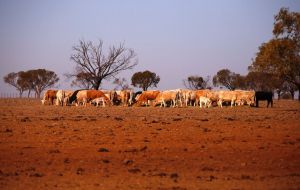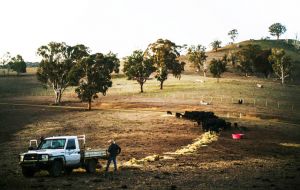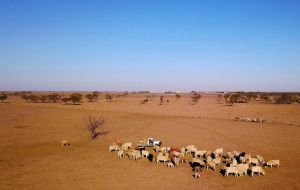MercoPress. South Atlantic News Agency
East Australia suffering worst drought in living memory: massive cull of livestock
 New South Wales with its fifth-driest July on record, has been hardest hit and about 99% of the state in officially in drought
New South Wales with its fifth-driest July on record, has been hardest hit and about 99% of the state in officially in drought  With grazing pastures turned to dust and feed costly and scarce, the drought is having a major impact on livestock
With grazing pastures turned to dust and feed costly and scarce, the drought is having a major impact on livestock  Farmers have been shipping in hay from growers in the country’s west or the far north to feed their livestock
Farmers have been shipping in hay from growers in the country’s west or the far north to feed their livestock  The livestock cull will ultimately leave the size of Australia’s national herd at a record low, ushering in a prolonged period of livestock rebuilding and higher prices
The livestock cull will ultimately leave the size of Australia’s national herd at a record low, ushering in a prolonged period of livestock rebuilding and higher prices The worst drought in living memory is sweeping parts of eastern Australia, leaving farmers struggling to cope and asking questions about their future. Record-low rainfall in some regions and successive seasons of above-average temperatures have blighted vast tracts of Australia's grazing and crop land.
While the weather has improved in parts of Western Australia, winter rain has gone missing across much of the country’s east, leaving farmers praying for rain after planting seed in dry soil or culling cattle and sheep they can no longer afford to feed.
New South Wales, which just recorded its fifth-driest July on record, has been hardest hit. About 99% of the state – which accounts for a quarter of Australia’s agricultural output by value – is now officially in drought.
With grazing pastures turned to dust and feed costly and scarce, the drought is having a major impact on livestock. Farmers have been shipping in hay from growers in the country’s west or the far north to feed their livestock. Even those sources are now being depleted, however, and as grain silos in the south are emptied, desperate owners are being forced to slaughter animals, even if it means it will take years for herds to recover.
The cull will ultimately leave the size of Australia’s national herd at a record low, ushering in a prolonged period of livestock rebuilding and higher prices for the industry.
Seeds rely not only on rainfall but also moisture already in the soil, which carries nutrients for plant growth and regulates soil temperature. The drought has devastated large swathes of eastern Australia's crop land, which supplies about a third of the nation's wheat.
Australia’s last winter was the warmest since records began more than a century ago and one of the 10 driest, sapping moisture from the earth. Dry conditions since have only made things worse, leaving farmers to plant dry and hope for rain to salvage their crops.
Last year, drought cut Australia’s output to the lowest level in a decade. This season has got off to an even worse start, with farmers planting in some of the driest soil in years.
Australia’s official forecaster has trimmed its estimate of this year’s wheat crop to 21.9 million tons, but warned yields would fall further without rain. Some private forecasters say the crop could be as low as 13 million tons, which would be the lowest since the drought-stricken 2008 harvest.
The ground in drought-hit regions has dried out to such a depth that it is even killing large trees. Scientists have reported more swathes of forest are dying off, while farmers point to trees that have survived 100 years on their properties but which are now dying before their eyes. Deep-rooted vegetation can access moisture down to levels of about six meters. However, these areas have been too dry for too long, and the effects are becoming visible.
The current dry period is not as extensive as the Millennium drought of 1997-2005, which devastated nearly 50% of the country’s agricultural land and was associated with two El Niño systems, which bring hot, dry weather to Australia.
But analysts and industry experts worry about how badly conditions have already deteriorated, especially since El Niño weather may be just around the corner.




Top Comments
Disclaimer & comment rulesCommenting for this story is now closed.
If you have a Facebook account, become a fan and comment on our Facebook Page!